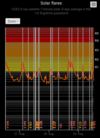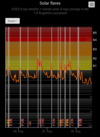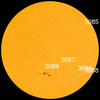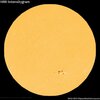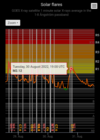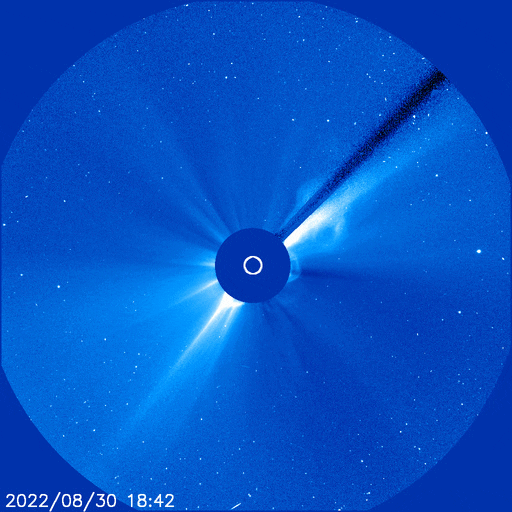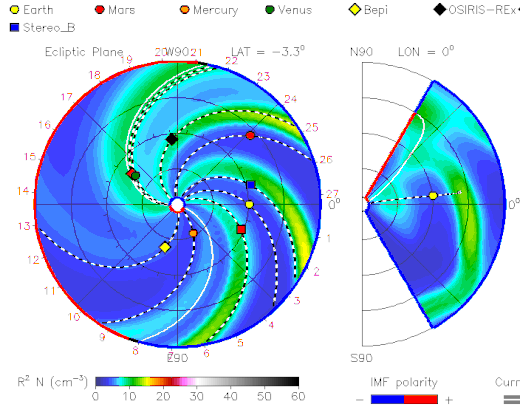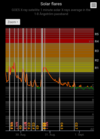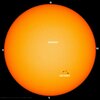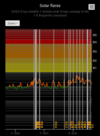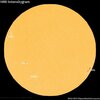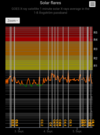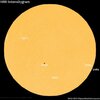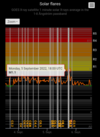I have realized that the big explosions are occurring in the hidden part of the earth from the sun and I have thought if there could be some celestial body that comes just from that direction and the sun does not allow it to be seen.
Just a thought.
Yes, I've noticed it too. Sunspots appear on the solar disk, a lot is expected of them and they only produce minor eruptions. Recently AR3088 for example. An X-class eruption was expected but didn't happen until it was on the far side. It may have reached class X if it had occurred on this side.
This region has now rotated out of view and probably the M8.7 was larger than what was recorded since the flare were partially blocked or occulted by the sun itself.
I was looking for information about this phenomenon but it seems that current science does not know either.
On june 2020 this question was asked in the
SpaceWeatherlive..com forum:
I have been watching the Sun for over a year now and I have noticed that during the summer of 2019 we had a few small sunspots form on the backside and die before they went over the east limb, and we have been seeing this again over the past month or so and I am curious whether we will get as many sunspots on the earth side as the far side. I am also curious whether there are causes to this.
Answer:
It's a research that hasn't been done because of the lack of data we have of the farside. Not every bright arc on Stereo is a sunspot region (unless they cause flares that can be observed from Stereo and is always very likely to be associated with a sunspot region) so it's difficult to get numbers from that side.
In SC24 we have also seen some major activity on the farside but those regions never survived long enough to have some activity left on the frontside. In any case, we will have regions that will form on the visible solar disk. there's just not a pattern to it to which longitude they will form and the lifetime of any region is also very variable.
So I looked for articles related to the electric universe theory.
Sunspot Mysteries
‘
If you would be a real seeker after truth, it is necessary that at least once in your life you doubt, as far as possible, all things.’
– Rene Descartes
Expressions of surprise and puzzlement are commonplace at new discoveries in astrophysics and the detailed sunspot photos provide their share.
It is because accepted theories have proven to be spectacularly non-predictive. It is a clear signal for independent minds that an opportunity exists to clear up mysteries that have dogged our finest scientists for most of the 20th century.
As Fred Hoyle long ago pointed out; the
Sun does not conform to the expected behavior of an internally heated ball of gas, simply radiating its energy into space. Instead, its behavior at every level is complex and baffling.
Nowhere is it more mysterious than in a sunspot. So, without any direct evidence that the thermonuclear powered model of the Sun is correct, and with strong evidence against it, we should begin by heeding Descartes advice and doubt it. Unfortunately it is a difficult path to take because
science is a powerfully consensual organization. Yet it is consensus, or general agreement, that can delay new ideas for centuries and sometimes, millennia.
There are many crippling agreements that hold up progress in astrophysics. One was succinctly expressed at a recent public meeting by a professor of astrophysics who admitted,
“‘When we don’t understand something we blame it on magnetism.”‘ The Sun has had more features blamed on magnetism than any other celestial object. The cool sunspot center is a classic example. Certainly, strong magnetic fields are measured there but that raises questions of cause and effect. Magnetic fields are only produced by electric currents. Is there any other evidence of electrical activity on the Sun? Yes, practically
every feature of the Sun can be understood in terms of electric discharge activity in plasma.
The penumbral filaments are a case in point. Electric discharges in plasma take the form of long thin filaments. Just like a neon tube, it is simply the discharge that causes the gases to glow. The penumbral filaments were observed to split near their ‘footpoints’ in the dark umbra and to move around. It is typical behavior of plasma filaments and can be observed in novelty plasma balls. But the greatest shock is that the penumbral filaments have dark cores! How could this be so if they are convecting gas? In that case, the filament center should be hottest and brightest.
An electric discharge offers a simple explanation. In an ELECTRIC UNIVERSE®
all bodies may receive electric current from the environment in a cosmic charging process associated with the normal development of a galaxy. And because electrical phenomena are scalable over at least 14 orders of magnitude, we may look to electric discharge phenomena in other atmospheres to gain insights into what may be happening in the Sun”s atmosphere.
Meteorologists are not sure how tornadoes form but they do know that they are often associated with severe electrical storms. The key to understanding tornadoes is that they are the result of rapidly rotating electric charge. Just as electrons are the current carriers in the copper wires we use for power transmission, so they are in the tornado. The BIG difference is that the electrons are moving at many metres per second in the tornado while they take several hours to move one metre in copper wire! The result is that enormously powerful electromagnetic forces are in control of the tornado. The result has been called a ‘charged sheath vortex.’
The Earth and other planets receive electrical power from space in the same way as the Sun. Obviously, we receive far less than does the Sun, which seems to be covered with tornadic charge sheath vortexes. The solar tornadoes are seen most clearly at the edge of sunspots in the form of penumbral filaments. The strong solenoidal magnetic field created by each vortex gives rise to the observed filamentary magnetic field in the penumbra.
What causes a sunspot?
In the electrical model, the
Sun receives electrical energy from interstellar space in the form of a glow discharge. Plasma experiments show that some energy will be stored in a donut shaped ‘plasmoid’ above the Sun’s equator.
The energy is released sporadically from the plasmoid to the mid-latitudes of the Sun. (Incidentally, plasmoid resonances may give rise to simultaneous flares on opposite sides of the central body, as recently reported on the Sun). The global tornado storm is pushed aside by more powerful charge sheath vortexes that deliver electrical energy from the plasmoid to much lower levels. The resulting holes in the tornado level, or photosphere, are what we call sunspots.
Rather than being a site where energy flow has been restricted, a sunspot is a site where it is enhanced. That explains why ‘they are launch pads for complex expulsions of plasma that race through the solar system.’ The giant electrical tornadoes that form sunspots accelerate particles in their powerful electromagnetic fields, generating UV light and x-rays instead of visible light. However, because temperature is a measure of random motion, the field-directed motion of the particles within the sunspot vortex appears ‘cool.’

www.holoscience.com
So, something is supercharging the sunspots on the non-visible side of the sun?


